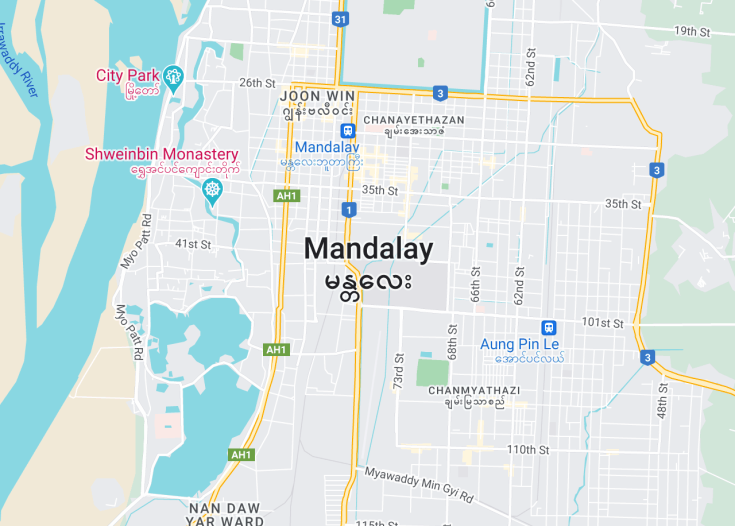Mandalay, the cultural capital of Myanmar, stands as a remarkable testament to Burmese history, religion, and artistry. This city, founded in the mid-19th century by King Mindon, aims to uphold the rich heritage of ancient Burmese royal cities. Visitors can explore significant historical sites, including the Royal Palace and Mandalay Hill, which provide insight into the city’s glorious past and spiritual significance. Engulfed in stunning architecture and bustling markets, Mandalay offers an authentic slice of Burmese life, presenting an array of traditional workshops like silk weaving and gold leaf beating.
Consider visiting during the cooler months from November to February when Mandalay’s weather is most pleasant, enhancing your experience of exploring its rich cultural landmarks.
While in Mandalay, ensure to catch the sunrise or sunset from the top of Mandalay Hill, offering panoramic views over the city and its surrounding countryside.
Top things to do & see in Mandalay
Select the following sights and activities to discover best tickets and tours available in Mandalay.
Mandalay: The Cultural Heart of Myanmar
| Country | Myanmar |
| Time in Mandalay | GMT+6:30 |
| Language spoken | Burmese |
| Population | 1,225,553 (source: Myanmar’s 2014 Census) |
| Currency | Burmese kyat (K, MMK) |
| Airports | Mandalay International Airport (MDL) (21 mi / 34 km). |
Mandalay, the second-largest city in Myanmar, stands out as a profound cultural and religious center. Founded in the mid-19th century by King Mindon, Mandalay is often seen as a major cultural hub of Myanmar. It serves as a crucial seat of Burmese culture, art, and education, also being the economic nerve-center of Upper Myanmar. Known for its ancient monasteries and vibrant traditional workshops producing gold leaf, tapestries, and silk, the city encapsulates the enduring spirit of Myanmar. Mandalay is historically significant for its role as the last royal capital of Myanmar before the British took control in the late 19th century. It’s also home to some of Myanmar’s most revered religious monuments, the Mandalay Hill, and the Mahamuni Buddha Temple, which attract thousands of pilgrims and visitors each year.
Where is Mandalay?
Mandalay is located in the central dry zone of Myanmar bordered by the potent Irrawaddy River to the west.
Distances:
| Route | Distance by car | Time by car |
|---|---|---|
| Yangon to Mandalay | 385 mi (620 km) | ~8-9 hours |
| Naypyidaw to Mandalay | 180 mi (290 km) | ~3-4 hours |
| Bagan to Mandalay | 117 mi (188 km) | ~3 hours |
What is Mandalay famous for?
Mandalay is renowned for its rich cultural heritage and historic sites, including the Royal Palace and numerous ancient temples. It’s also famous for its craftsmanship in traditional arts such as wood and stone carving, and gold leaf beating.
History
Early Settlements to 1857
The area of Mandalay has a recorded history dating back to the first inhabitants who settled in this part of Myanmar. Ancient chronicles describe small village communities and a landscape rich in resources which supported early human settlement. King Mindon founded Mandalay in 1857 to fulfill a prophecy and establish the capital near the foot of Mandalay Hill, believed to be a sacred place.
1857 – Present Day
Post-establishment, Mandalay became the last royal capital of the Burmese kingdom before the British conquest in 1885. Following the annexation, it transformed into a major commercial and educational center under British rule. After independence in 1948, Mandalay continued to flourish, though it faced numerous challenges including political upheavals and natural disasters. Through resilience, it remains a vital cultural and economic hub in modern Myanmar.
Visit Mandalay
What to see and do in Mandalay
Exploring Mandalay offers a spectrum of experiences from ancient pagodas to contemporary markets. Noteworthy attractions include:
- The Mandalay Royal Palace, a majestic example of traditional architecture.
- Mandalay Hill, offering panoramic views of the city and a patchwork of pagodas and monasteries that dot its slopes.
- Kuthodaw Pagoda, known as the world’s largest book for its 729 marble slabs inscribed with Buddhist teachings.
- The lively atmosphere of the Zegyo Market, where visitors can find everything from fresh produce to local crafts.
Annual Events in Mandalay
Mandalay’s calendar buzzes with vibrant festivals. Key events include:
- The Thingyan Water Festival (April), marking the Burmese New Year with lively water throwing celebrations.
- The Taung Byone Nat Festival (August), which is famous for its spirited nat (spirit) worship and traditional dance performances.
Best time to visit Mandalay
The ideal time for a visit is between November and February when the weather is dry and cool, making city exploration and sightseeing more comfortable.
Is Mandalay worth visiting?
Mandalay is undoubtedly a destination rich in cultural heritage and unique experiences. Its appeal lies in its blend of historical palaces, stunning religious edificates, and bustling local markets. However, visitors should be prepared for the bustling city life that can sometimes be overwhelming with hectic traffic and crowds, especially during festival periods. Despite these challenges, the city’s charm and the warmth of its people make it a worthwhile destination for those interested in exploring a vital part of Myanmar’s cultural fabric.










